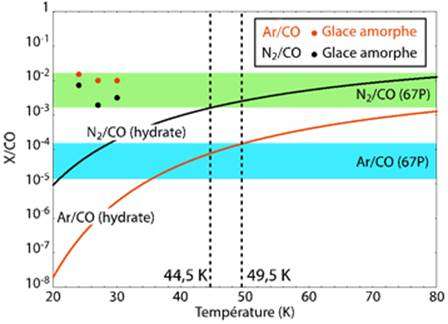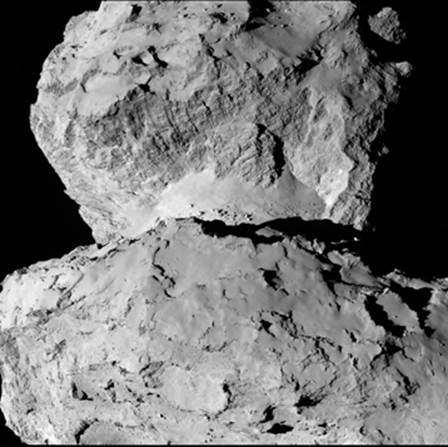Type of ice reveals the age of comets

The ice buried inside comet 67P/ Churyumov-Gerasimenko is mainly found in crystalline form, which implies that it originated in the protosolar nebula and is therefore the same age as the Solar System. This discovery was made by an international team led by a researcher at the LAM (CNRS/Aix Marseille Université) and also including scientists from the Laboratoire J.-L. Lagrange (OCA/CNRS/Université Nice Sophia Antipolis) and the Centre de Recherches Pétrographiques et Géochimiques (CNRS/ Université de Lorraine), with support from the CNES. Their findings were obtained by analyzing data from the Rosina instrument, placed on board ESA's Rosetta spacecraft. This work has been published on 08 March 2016 in The Astrophysical Journal Letters.
Little by little, the Rosetta mission is uncovering the secrets of comets, and has now succeeded in settling a decades-old debate about the nature of their ice. Until now, there were two opposing hypotheses, one that the ice is crystalline, and the water molecules are arranged in a regular pattern, and the other that the ice is amorphous, and the water molecules are disordered. This question is especially important because of its implications for the origin and formation of comets and the Solar System.
The issue has now been settled thanks to the Rosetta spacecraft's Rosina instrument. This is a mass spectrometer, which in October 2014 first measured amounts of molecular nitrogen (N2), carbon monoxide (CO) and argon (Ar) in Churi's ice. The data was compared with that from laboratory experiments on amorphous ice, as well as from models describing the composition of gas hydrates, a type of crystalline ice in which water molecules can trap molecules of gas. The ratios of molecular nitrogen and argon found in Churi correspond to those in the gas hydrate model, while the amount of argon detected in Churi is a hundred times smaller than the quantity that can be trapped in amorphous ice. The ice in the comet therefore definitely has a crystalline structure.
This is a major discovery, since it makes it possible to determine the age of comets. Gas hydrates are made of crystalline ice that formed in the protosolar nebula (which gave rise to the early Solar System) from the crystallization of grains of water ice and the adsorption of gas molecules onto their surfaces as the nebula slowly cooled. If comets are made of crystalline ice, this means that they must have formed at the same time as the Solar System, rather than earlier in the interstellar medium. The crystalline structure of comets also shows that the protosolar nebula was hot and dense enough to sublime the amorphous ice that came from the interstellar medium. The gas hydrates agglomerated by Churi must have formed between -228 °C and -223 °C to produce the observed abundances. This work also lends weight to scenarios for the formation of the gas giant planets, as well as their moons, which require the agglomeration of crystalline ice.

More information: O. Mousis et al. A PROTOSOLAR NEBULA ORIGIN FOR THE ICES AGGLOMERATED BY COMET 67P/CHURYUMOV–GERASIMENKO, The Astrophysical Journal (2016). DOI: 10.3847/2041-8205/819/2/L33
Journal information: Astrophysical Journal Letters , Astrophysical Journal
Provided by CNRS





















